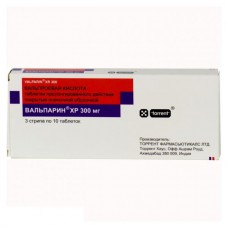Expiration date: 01/2025
VALPARIN® XP (VALPARIN XR)
Representation:
TORRENT Pharmaceuticals Co., Ltd. ATX code: N03AG01 owner of the registration certificate:
TORRENT PHARMACEUTICALS, Ltd.
Release form, composition and packing
Tablets prolonged action covered with a cover of white color, round, biconcave.
Other ingredients: colloidal silicon dioxide, hydroxypropyl methylcellulose, ethyl cellulose, silicon dioxide hydrate, sodium saccharin, glycerin, titanium dioxide, E 100 evdragit, evdragit NE-30D, polyethylene glycol 1500 talk.10 piece. - The strips (10) - packs kartonnye.Tabletk depot coated white, oblong, scored on both storonah.Vspomogatelnye ingredients: colloidal silicon dioxide, hydroxypropyl methylcellulose, ethyl cellulose, silicon dioxide hydrate, sodium saccharin, glycerin, titanium dioxide, evdragit E-100 evdragit NE-30D, polyethylene glycol 1500 talk.10 piece. - Strips (10) - packs kartonnye.Kliniko-pharmacological group: anticonvulsant preparatRegistratsionnye ??:
Tablets prolonged action 300 or 500 mg: 30 or 100 pcs.
1. One tablet contains:
Sodium valproate 200 mg
valproic acid, 87 mg,
corresponding to a total content of sodium valproate 300 mg
2. One tablet contains:
Sodium valproate 333 mg
valproic acid 145 mg,
corresponding to a total content of sodium valproate 500 mg
pharmachologic effect
Anticonvulsants. Sodium valproate increases the content of gamma-aminobutyric acid (GABA) in the brain, which correspondingly increases the content of GABA in the postsynaptic neurons. Moreover, sodium valproate affects the transfer of potassium ions across neuronal membranes. As a result, development inhibition and excitation by rsprostraneniya epileptic neurons.
Sodium valproate has anticonvulsant activity in various types of epilepsy in humans. The drug does not have a pronounced hypnotic and sedative effects, and has no inhibitory effect on the respiratory center. Sodium valproate has no adverse effect on blood pressure, heart rate, renal function and body temperature.
Pharmacokinetics
Suction
After oral tablets with controlled release in plasma Cmax is reached within 2-8 hours of the drug Bioavailability -. About 100%.
Therapeutic effectiveness is manifested in concentration of valproic acid in blood plasma of 40-100 m / l. At the same time, the pharmacological and therapeutic effects of the drug controlled release does not always depend on its concentration in plasma.
Distribution
Binding to plasma proteins is 80-90%.
Vd is 0.2 L / kg.
Metabolism and excretion
It is metabolized in the liver and excreted in the urine. First-pass metabolism is not marked. T1 / 2 of approximately 8-20 hours.
Pharmacokinetics in special clinical situations
In children, T1 / 2 is decreased.
testimony
Treatment or generalized partial epilepsy, especially when these types of seizures:
- Absences,
- Myoclonic,
- Tonic-clonic,
- Atonic.
Partial epilepsy:
- Simple or combined seizures
- Secondary generalized seizures.
The specific syndromes (West, Lennox-Gastaut syndrome).
dosage
The dosage regimen is selected individually depending on the age and weight of the patient.
Adult starting dose is 600 mg / day, followed by increasing doses up to 200 mg every 3 days until the optimum effect. Multiplicity of reception - 1-2 times / day. The maximum recommended dose of 1-2 g / day.
The tablets should be swallowed whole with a little water.
Elderly patients valparin XP dosing regimen similar to the dosing schedule for adults and adjusted individually.
For children weighing more than 20 kg initial dose - 400 mg / day. The dose should be increased posepenno to achieve optimal values ??- usually 20-30 mg / kg / day in 1 or 2 divided doses.
In children weighing up to 20 kg should not be used valparin XP.
Side effect
From the digestive system: rarely - nausea, vomiting, diarrhea and / or constipation, hepatitis, pancreatitis.
Allergic reactions: seldom - skin rash, itching, photosensitivity, erythema multiforme, Stevens-Johnson syndrome.
CNS: rarely - ataxia, tremor, impaired consciousness, coma.
On the part of the reproductive system: rarely - a violation of the menstrual cycle, secondary amenorrhea.
Hematopoietic system: rarely - anemia, thrombocytopenia, neutropenia, leukopenia, decreased fibrinogen, platelet aggregation inhibition.
Other: 2-12% - hair loss, rarely - weight gain, hyperammonaemia, serum creatinine.
Contraindications
- Severe disorders of the pancreas,
- Acute or chronic hepatitis, active hepatitis cases of family history (primarily drug genesis)
- Porphyria
- Thrombocytopenia,
- Pregnancy,
- Lactation (breastfeeding)
- Children up to age 3 years,
- Hypersensitivity to valproic acid and other ingredients.
Pregnancy and breast-feeding
Appointment of the drug during pregnancy is possible only when the intended benefits to the mother outweighs the potential risk to the fetus. In the case of receiving the drug during pregnancy is required to conduct specialized prenatal monitoring of the fruit.
Use of the drug in breast-feeding period is not recommended.
Application for violations of liver function
Contraindicated in acute or chronic hepatitis, active hepatitis cases, a family history (primarily drug genesis
special instructions
The need for regular monitoring of transaminases, bilirubin, blood platelets, amylase (every 3 months).
Valproic acid inhibits platelet aggregation, which increases the risk of increased blood clotting bleeding. It is necessary to consider the possibility of complications related to bleeding in the postoperative period in patients receiving sodium valproate. Chronic administration of sodium valproate may develop spontaneous bruising and bleeding. In this case, you should immediately stop taking the drug.
Sodium valproate can cause drug pancreatitis and liver dysfunction (usually in the first 6 months of use). In connection with this it is necessary during the first 23 months of treatment, monitor the status of the pancreas, liver function tests to conduct, to monitor the levels of prothrombin. Violation of the liver, liver failure on the background of sodium valproate therapy are sometimes observed in children with epilepsy and combined metabolic and degenerative disorders, organic disorders of the brain tissue, and delayed mental development. If you have symptoms such as severe weakness, lethargy, swelling, vomiting, jaundice, you should immediately stop using the product.
Effects on ability to drive vehicles and management mechanisms
Patients should use caution when operating machinery, because the drug reduces the ability to concentrate.
Overdose
It was reported about rare cases of accidental or intentional overdose.
Symptoms include nausea, vomiting, dizziness, diarrhea, respiratory depression, hyporeflexia, coma.
Treatment: gastric lavage, activated charcoal. If necessary - patient treatment with symptomatic therapy, hemodialysis.
Drug interactions
Sodium valproate increases the effects of antipsychotics, anticonvulsants and antidepressants. Unlike other anticonvulsants, sodium valproate causes no induction of liver enzymes, however does not reduce the effectiveness of oral contraceptives.
When combined with sodium valproate and warfarin reduced the percentage of binding to plasma proteins of the latter.
Sodium valproate modifies the plasma concentrations of phenytoin and lamotrigine. In combination with anticoagulants and acetylsalicylic acid derivatives intensified antiplatelet effect.
Terms and Conditions of storage
The drug should be stored at temperatures below 30 ° C in a dry place inaccessible to children.
Shelf life - 3 years.




